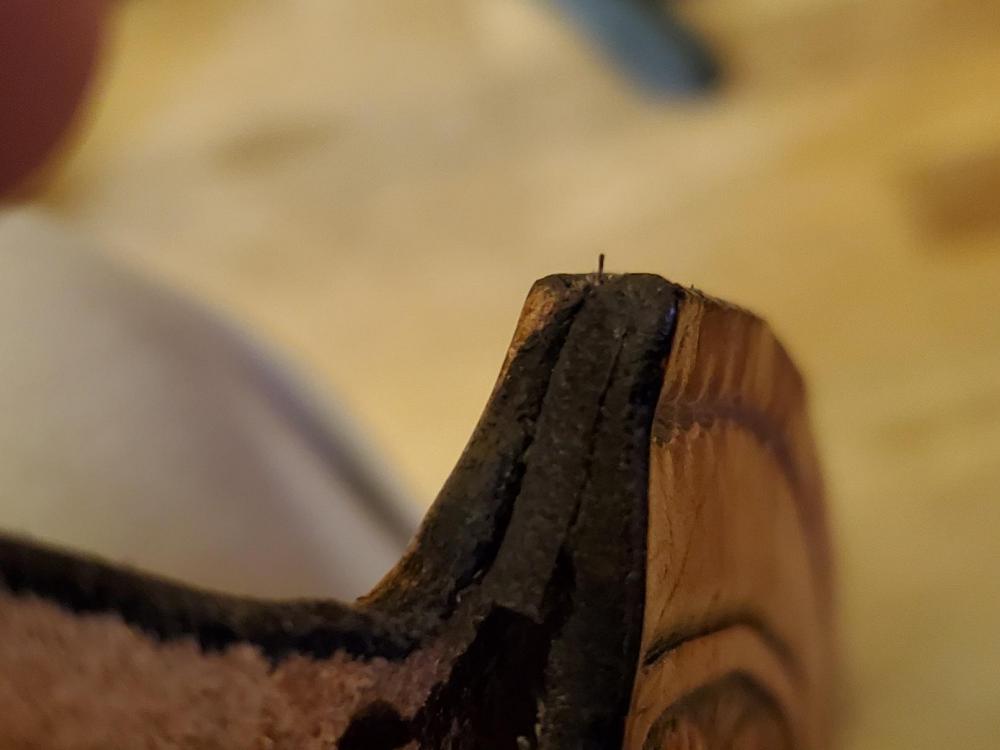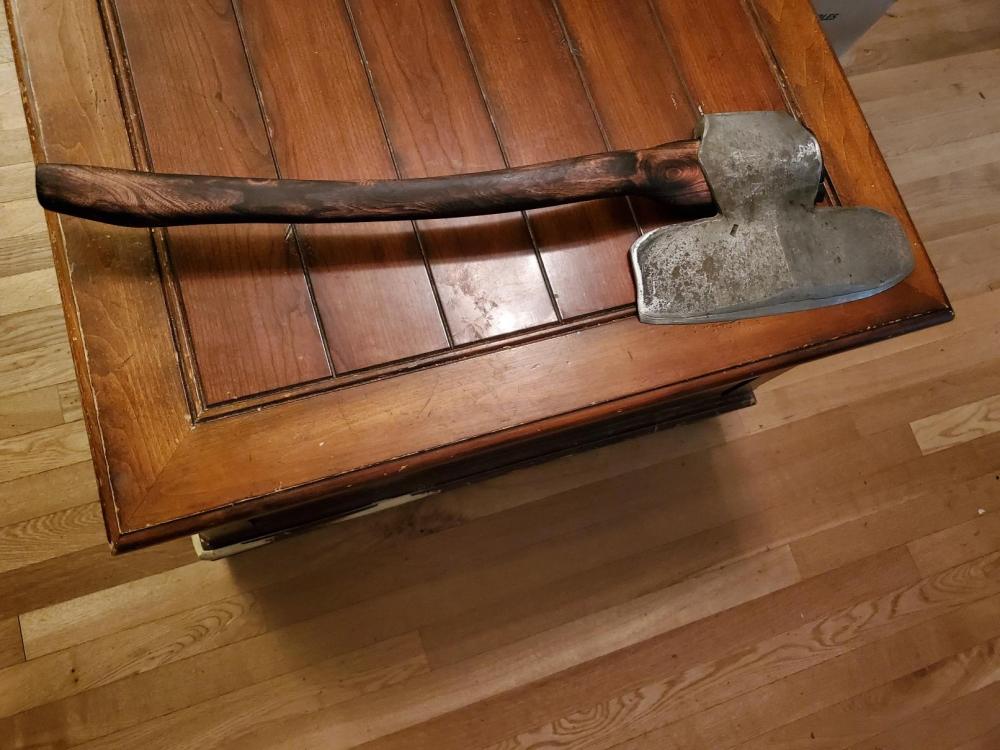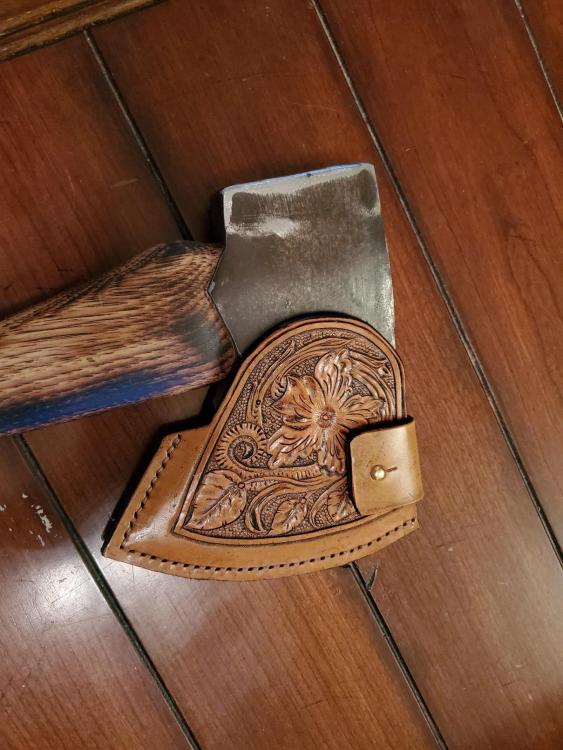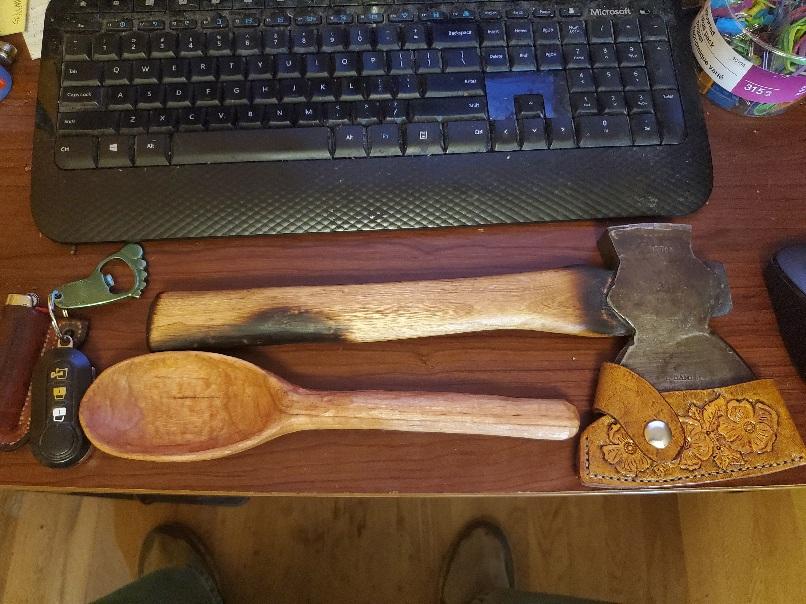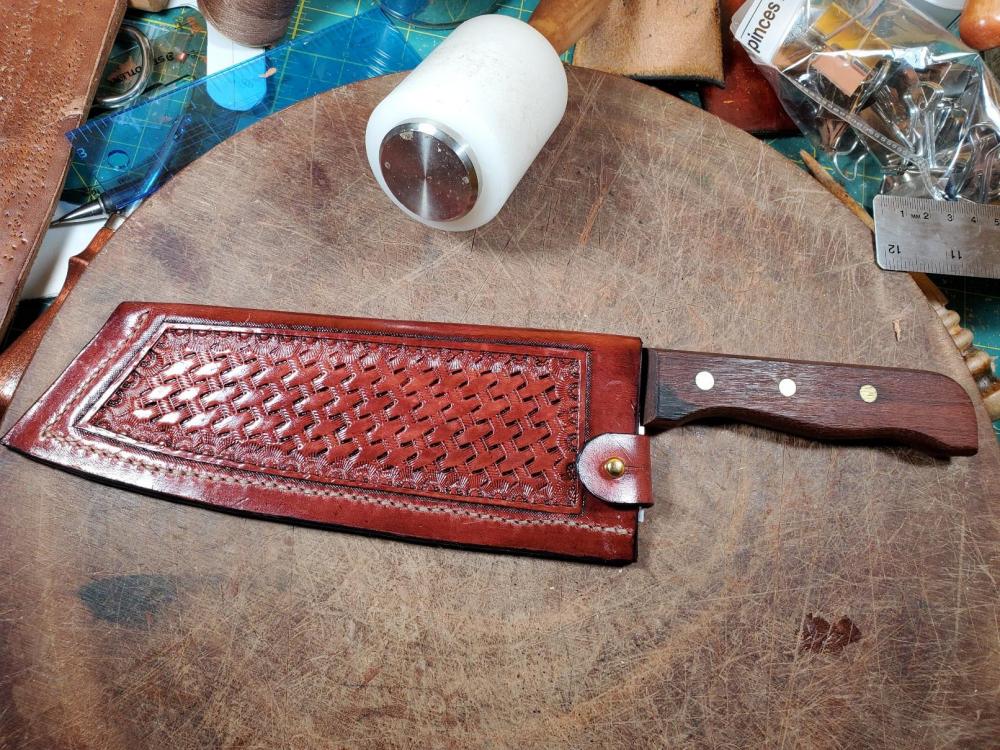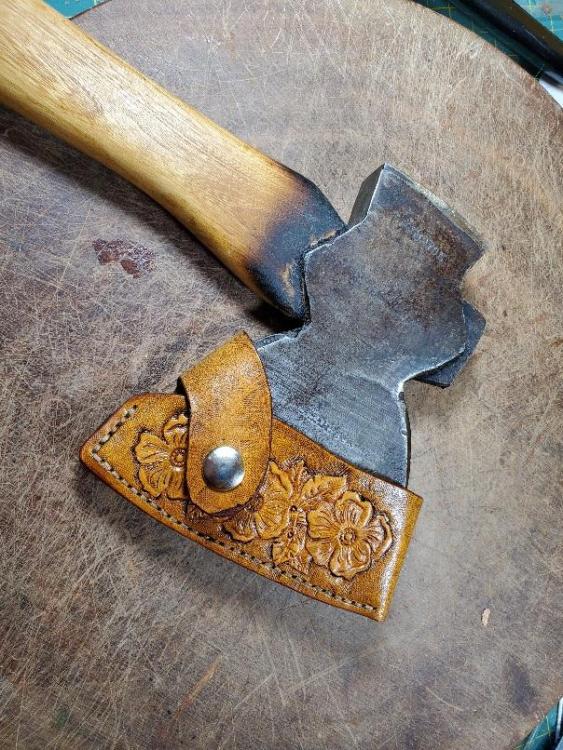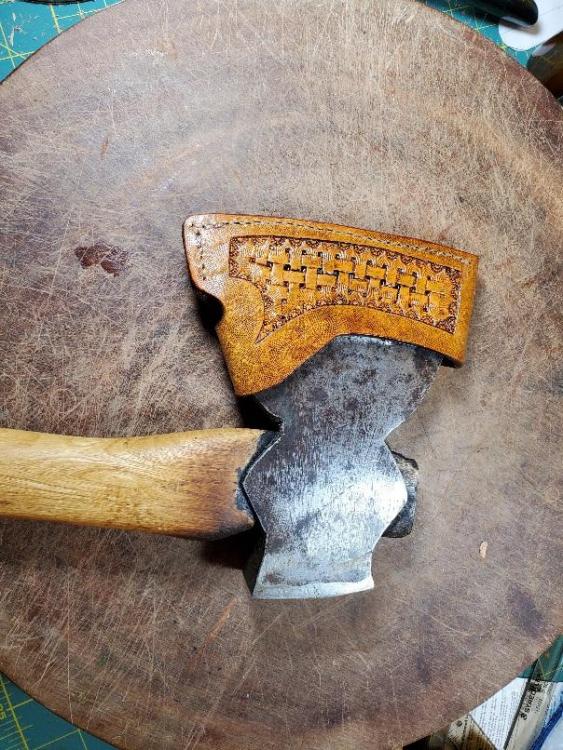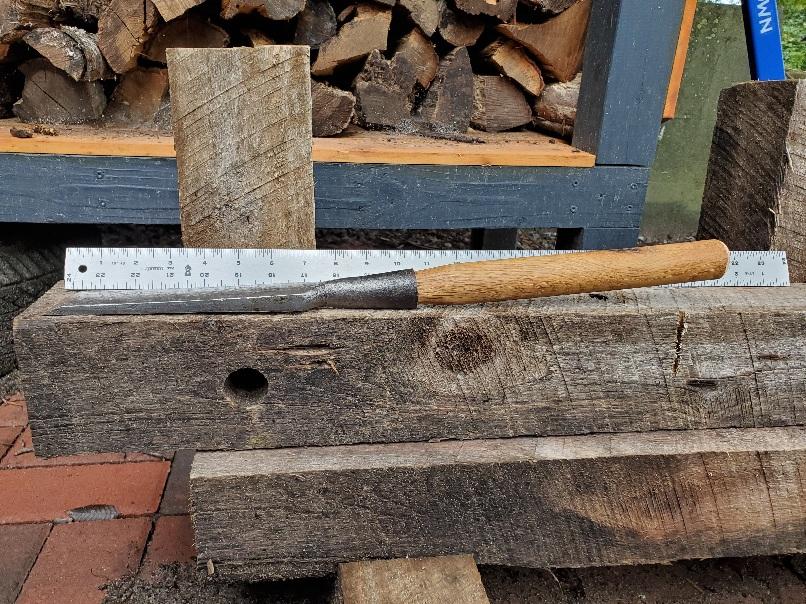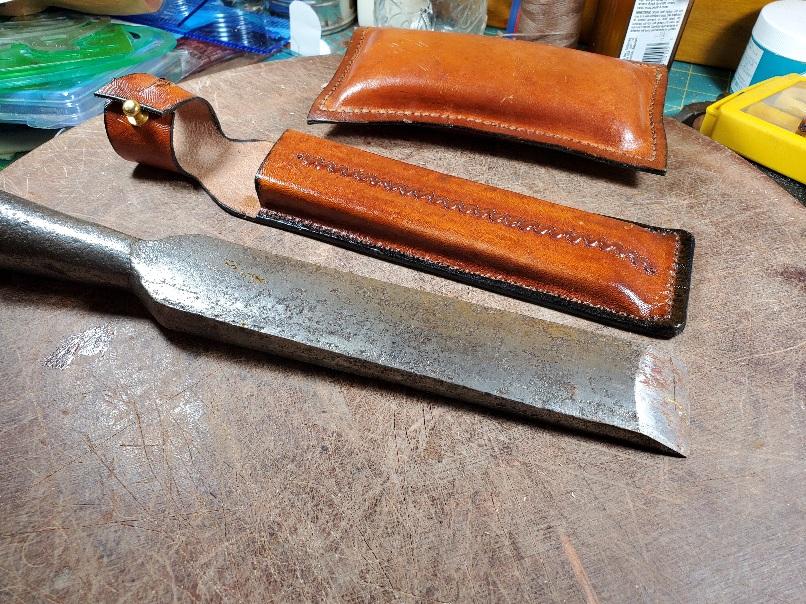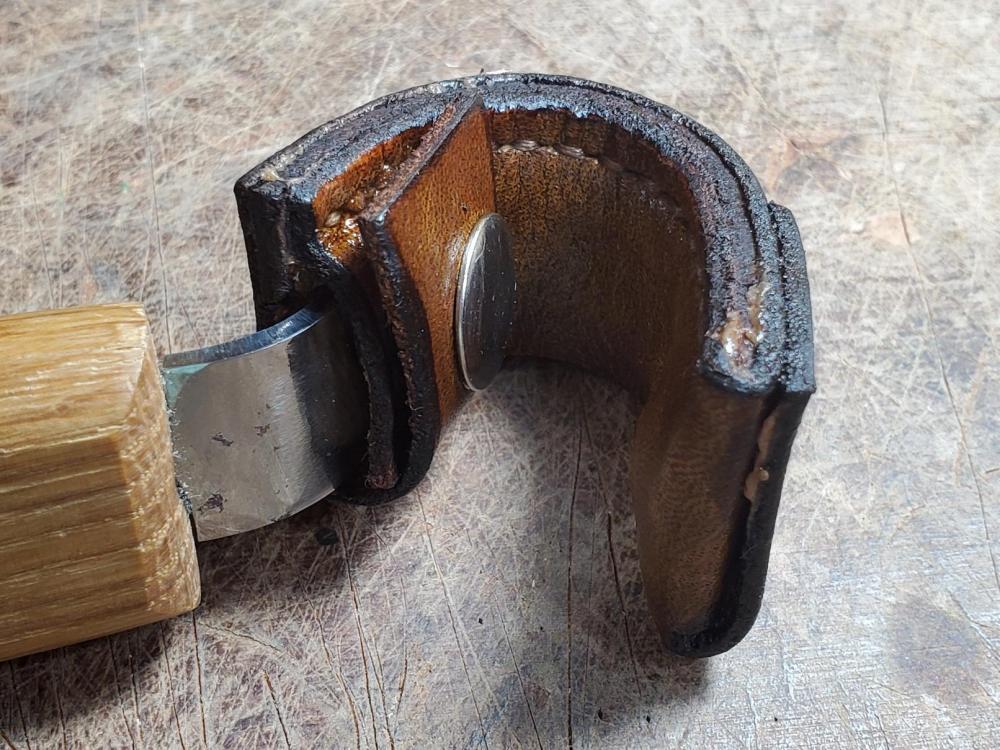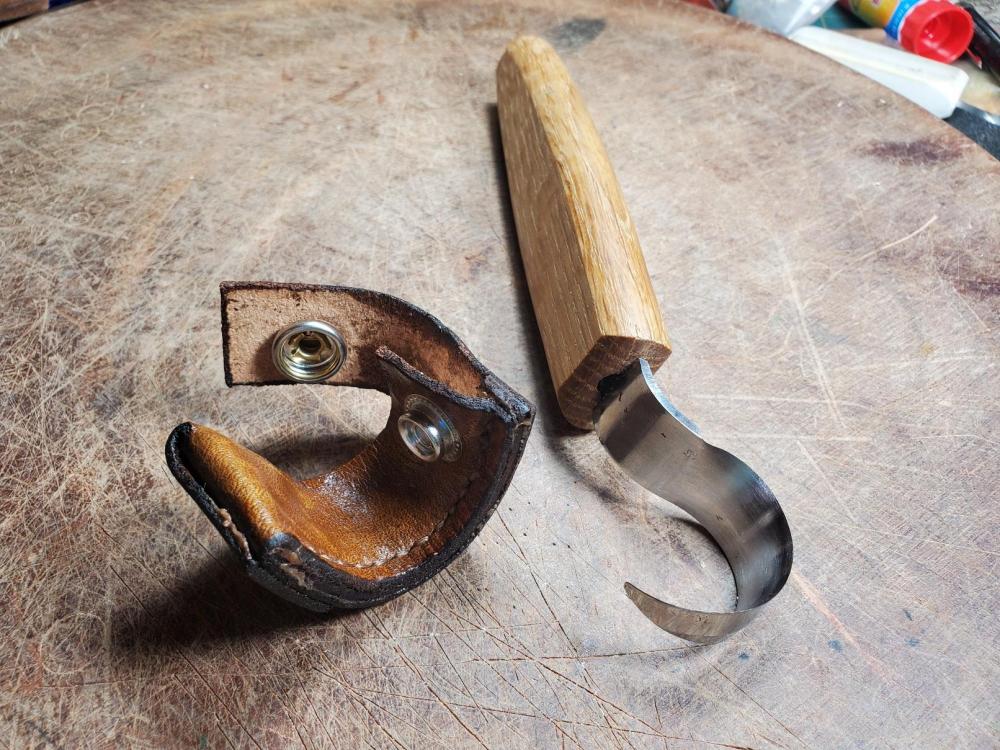
Woodshed
Members-
Posts
89 -
Joined
-
Last visited
Content Type
Profiles
Forums
Events
Blogs
Gallery
Everything posted by Woodshed
-
Yes, the stitches are fully protected by a thick leather bolster. All pieces are skived down to reduce overall thickness and make the stitching a bit easier (its still not easy with leather so thick), but the bolster itself is full width along the cutting edge.
-
Aye! A round to us all, and good health! Here is another axe sheath project I'm looking forward to. it's an early 1880s blacksmith made broad axe, and man was it was a beat up mess. Now that it's spiffied up, re-handled, and the 12 inch edge is razor sharp and ready for action, it needs a sheath. Should be a fun project. Definitely one for thick leather; it's heavy.
-
Well, I kept looking at that sheath and seeing things I didn't like. Its just too wonky. So rather than call it quits and sending it to my son, I have remade the sheath to hopefully shake out most of the stuff that didn't age well with me. I could make it yet again and continue to improve it, but that would be overkill when there are new projects to tackle. This will do.
-
My first year of leatherworking has ended. I don't know how much money I've spent, but it could always be more! One thing for sure, I really enjoy it, and glad I decided to make a few sheaths for my edge tools. My first leather items were functional but poorly crafted, and are gradually being replaced by items which benefit from lessons learned so far. I never knew how much I didn't know about craftsmanship until I started trying to make stuff. The learning never ends. The need for tools never ends either! Anyway, Happy New Year y'all!
-
The most expensive wallet on my life (with greetings from Spain)
Woodshed replied to JanLeather's topic in Member Gallery
Great story, great journey! I thought my leather story would end after a few sheaths. How little I knew! I'm one year in, and a handful of tools is now a bench full, and the end is not in sight! -
Wow! That is so cool!
-
Shiver me timbers! So cool!
-
Man that is nice!
-
Sheath for Spoonmakers's Adze
Woodshed replied to Woodshed's topic in Gun Holsters, Rifle Slings and Knife Sheathes
I got a chance to test it with a chunk of cherry firewood. I had a go at it with a hatchet to get the big stuff cut away first. Then final shaping was all adze. It did equally well on concave and convex curves, with no tearouts! All the subsequent knife work was clean up and refinement. The key was to keep the shavings thin and shape it gradually until it was time to go to knives. Fun stuff! -
Thanks! I love old axes, and I hope that's how my son feels about it!
-
My oldest son added a wood-fired sauna and a woodshed in his back yard about two weeks ago. Realizing something was missing, he called asking me to build him an axe. So I got an old Collins phantom bevel head, de-burred, sharpened and re-handled it, and made this sheath. It chops and splits wood like an eager beaver. If he doesn't like it he can ship it back to me!
-
Sheath for Kom Kom knife
Woodshed replied to Woodshed's topic in Gun Holsters, Rifle Slings and Knife Sheathes
Definitely has a welt! It has a really sharp edge now l but I don't know how long it will hold it, as it is a thin stamped stainless blade of unknown pedigree/hardness. Bevels sharpened at 15 degrees with a 1200 3000 6000 grit progression on whetstones, then stropped; it's scary sharp atm. -
Surgically sharp knife bloodied my index finger tip two days ago. Still need band aids! I got the knife at local Asian market for next to nothing simply wanting to evaluate its utility. It takes an edge. The points are dangerous. Bloodied finger tip taught me to use only a pinch grip with this knife. Other than that it slices and chops well when sharp. It doesn't have much backbone. But its great for softer veggies. First time to angle the basket stamp so it doesn't run off the edge of the window. First time to deliberately orient a button hole correctly !
-
Hewing Hatchet Bra
Woodshed replied to Woodshed's topic in Gun Holsters, Rifle Slings and Knife Sheathes
Thanks! I go for the old iron myself, seems like I can never have enough, and eBay makes it too easy to find more old edge tools to refurbish (i.e., play with ) -
I just finished building this hewing hatchet (side axe) for my youngest son (a belated birthday present). It is a Sears & Roebuck head, which makes it fairly early 1900s, as it predates their Fulton and Craftsman branding.
-
Yes, there is a bolster, but just at the tip end to protect the stitches there. The side stitches don't need protection. Because the weight of the tool is similar to that of a hatchet, I'll use 8-9 oz leather for the next go at it. That is the thickness that I'm preferring for hatchet and axe sheaths so I've started keeping some on hand at all times. Making stitching holes in thick build ups is challenging; lately I've been marking and making the holes on the front panel first, using a stitching wheel and awls. Once the back panels are glued in place, I use the holes in the front panel as a guide and continue the holes the rest of the way through the back panel. Going to this two-step process adds just a few minutes to the build time, but cuts the working thickness down and the awl work is a bit easier.
-
Yes it is wrong, not deliberately but due to my ignorance! :p Thanks for pointing that out! I had not thought of that before, so that's info I can use from now on. Awesome! And you are also correct. The tool is a beast, so much so it makes it fun to use!
-
It is a timber framing slick, a chisel that allows cutting mortises through big timbers without barking one's knuckles. Really a must have tool for a timber framer. The handle socket is canked upward which keeps the knuckles above the wood safely. It is 20" long and weighs close to 1 1/2 lb.
-
Thanks! I like the design better than the execution. I'd use heavier leather today.
-
When I got this 1 7/16" slick early this year it needed sharpening a handle and a sheath. So this sheath is part of the first wave of sheaths I made, but even having that strike against it, it's functional and doesn't slip off the slick. It's a big heavy chunk of sharp metal to look out for!
-
Schofield Gun Rig
Woodshed replied to JWheeler331's topic in Gun Holsters, Rifle Slings and Knife Sheathes
Beautiful! -
Wallet
Woodshed replied to DustinSmith's topic in Purses, Wallets, Belts and Miscellaneous Pocket Items
Nice! The snake looks alive, the scales flow just right and bring it to life. Fine job! -
The hook knife is small but very sharp. The sheath is one piece of leather shaped like the letter F, with a 3/8" wide bolster along the stitch line. The inner part of the fold is about 3/8" shorter than the outer, as it's curve has a smaller radius. A quick build, nothing fancy. Another leather scrap isn't scrap anymore!


